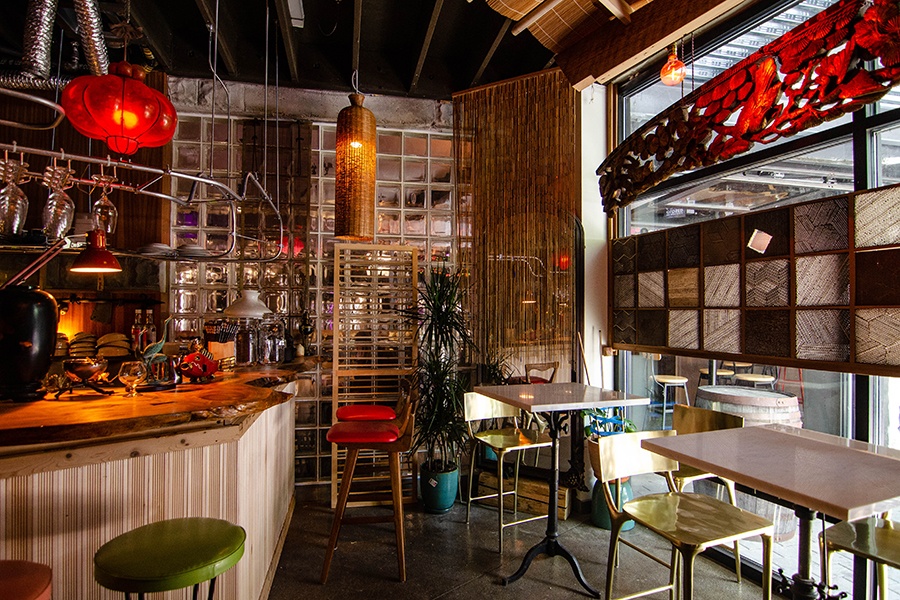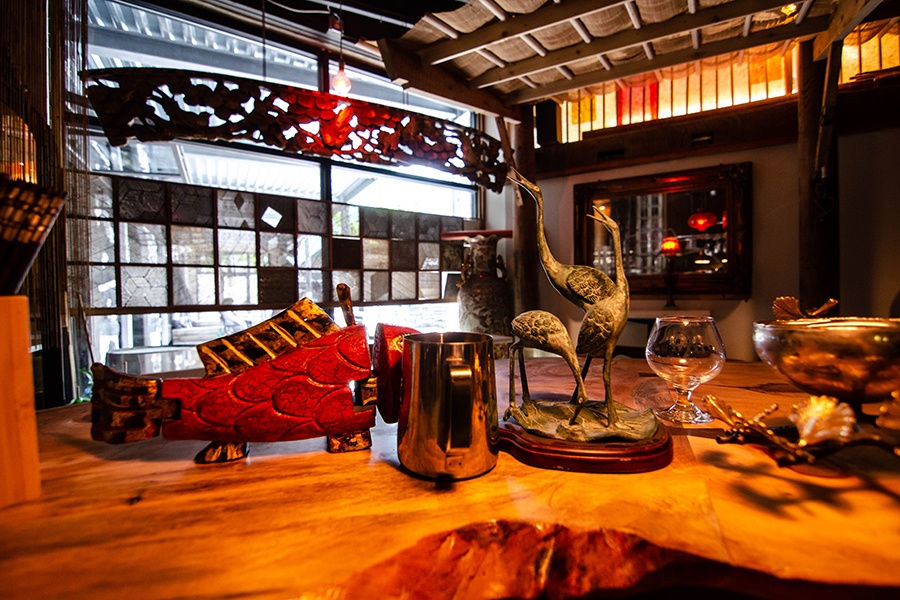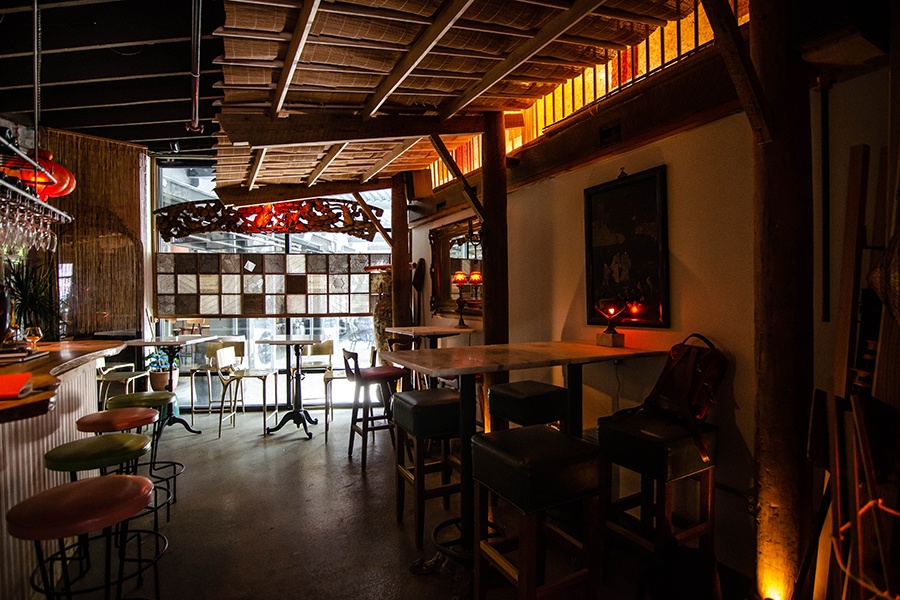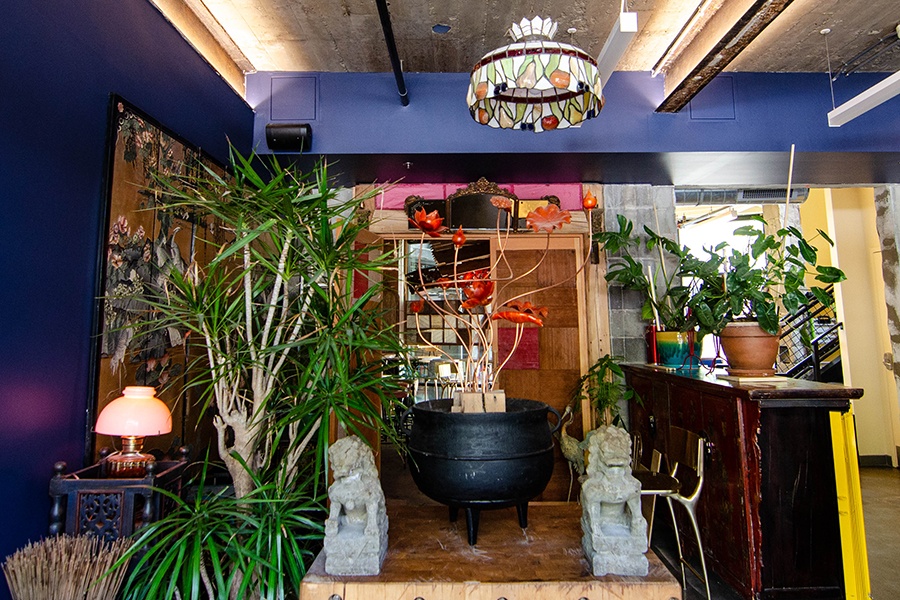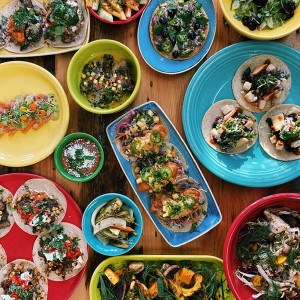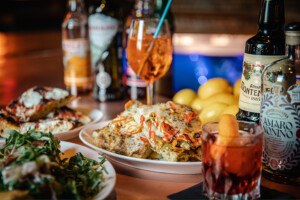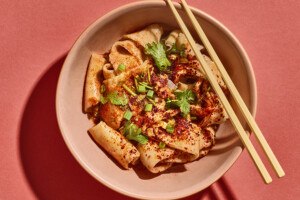The Eaves Tells a Story of a Life in Two Places Through Creative Vietnamese Food and Cocktails
Tucked away in an intimate, unique space, the new Somerville restaurant—or is it a bar?—feels like home, whether home is New England or Vietnam.
Maybe it’s the pumping disco beat from a playlist that leaps from Boney M.’s “Rasputin” to the Bee Gees’ “Stayin’ Alive”; maybe it’s the sneaky heat at the bottom of a bowl of betel-leaf-wrapped beef and rice noodles; maybe it’s the eclectic décor, a carefully curated mix of objects collected around New England. Whatever it is, Somerville newcomer the Eaves will sweep you off your feet from the moment you step inside the quirky, intimate space, a former under-utilized storage area of Bow Market’s lobby. Steps from the elevators, you’re transported to a dazzling hideaway with an ever-changing menu of Vietnamese dishes and bold-flavored cocktails. Depending on your mood and the time of day, it may feel more like a restaurant or more like a bar—but you can think of it as “just a place you want to stay,” as the team puts it.
The Eaves, which recently debuted with some soft-opening previews and will open with a regular schedule on September 2, is the latest project from chef Vincenzo Le (a 2023 James Beard award semifinalist) and Duong Huynh, who are also behind Cambridge coffee-and-more stunner Cicada. At the Eaves, the duo blends their Vietnamese roots with the life they’ve built here in New England, with every detail of the intricately designed space, every item on the menu, an ode to a life lived in more than one place.
This combining of cultures results in something homey and welcoming. “It’s like going to a friend’s house,” says Huynh. “You come over, and you never know what your friend is cooking, but you know you’re going to have a good time and leave happy. That’s really the spirit of our hospitality. Come and have a good time, a unique time.”
Following that vibe, the menu will change frequently with the team’s mood, the weather, the available supplies—in short, don’t get too attached to the idea of a specific dish you’ve seen online or read about here. Go in with an open mind and an appetite for experimentation: “Be tender” is the philosophy of the Eaves, and Le and Huynh’s plea to customers (and reminder to themselves and their team). In essence, be patient, be curious, be kind.
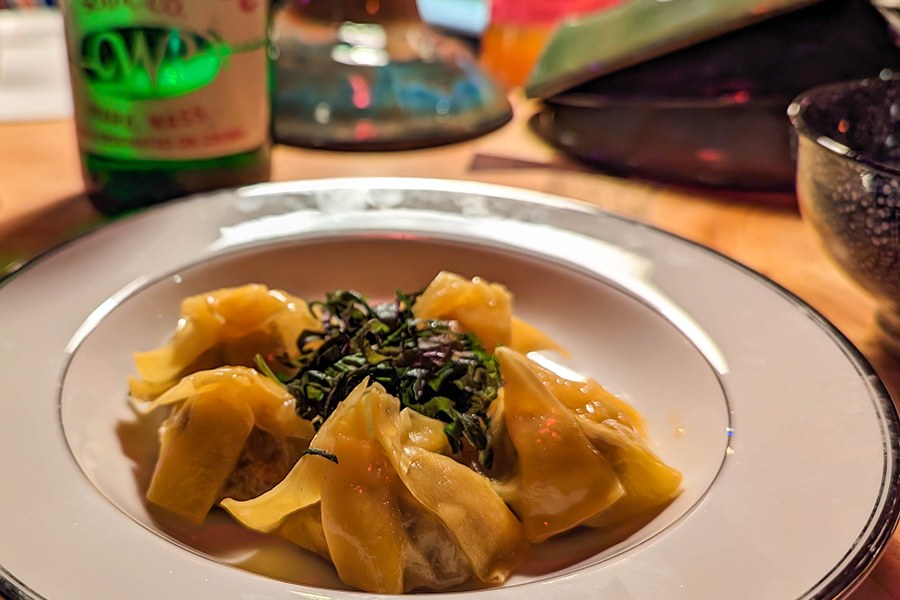
Duck confit dumplings (há cảo vịt) at a soft-opening dinner at the Eaves. / Photo by Rachel Leah Blumenthal
“That’s how we can have a good, enjoyable time together in this small space,” says Huynh. “Everybody’s time is precious, and we want to be transparent about who we are because we want people to enjoy themselves and what we have to offer when they walk in the door.”
While you should go in with an affinity for surprises, you understandably want at least an idea of what you’re in for food-wise. Expect smaller plates, designed so you can try several dishes. Flavors are “very fresh and some is very spicy, no compromise,” says Le. (He means it: “When I make something spicy, it’s supposed to be my level of spicy.”) He also aims to balance elegance with bold and strong tastes, he says.
At a recent meal in the soft-opening period, one standout dish that embodied that balance was há cảo vịt, irresistible little dumplings stuffed with duck confit. They were topped with a garnish of red shiso, an herb with a bracing bite that acted as the perfect foil to the savory duck. Duck confit also starred in a black rice dish, with lemongrass and pickled papaya adding a parade of herbal, sweet, and sour flavors to the mix. Also memorable? The aforementioned betel-wrapped beef (bò lá lốt)—salty-smoky chunks of beef over springy fresh rice noodles, punches of flavor coming from the Vietnamese fermented anchovy sauce mắm nêm and a squeeze of lime.
Le grew up in northern Vietnam and spent about a decade in the country’s south, starting at age 18. “The north is very bold in my heart, in my soul,” he says, “but the food from the south affects me a lot. I like the freshness, the sour, the spicy, the slightly sweet.” Northern cuisine is “more elegant,” he says, and doesn’t include much seafood as it’s a colder, mountainous region. Southern cuisine, on the other hand, is full of fresh seafood. “I love both,” he says. And so the food at the Eaves is not meant to be specific to one region but drawn from bits and pieces here and there, and tailored to New England ingredients. “It’s us, it’s me,” he says.
Le approaches his dishes like an architect—probably no surprise, as he has a background in architecture and urban design. He drills down to the core principle of a traditional Vietnamese dish, whether that’s a specific technique or combination of flavors, distills the essence, and brings it here to create something new. “The structure, the layout, the contrast, and the core principle of the taste [of a dish] will be moved from Vietnam to here,” he says, “playing with local ingredients” like seafood sourced from Captain Marden’s and meats from Savenor’s.
Like the food, the drinks will rotate frequently. In general, the drink program at the Eaves has three parts to it, with a focus on two: “a brief, but colorful, selection of sakes,” says Huynh, and taster-sized cocktails. The third piece, less a focus but still delightful, is a small natural wine selection, “just enough to complement the dishes.”
Highlighting sake “comes from a very Vietnamese mindset,” says Huynh. “In Vietnam, the tradition of brewing rice wine and rice liquor has been around for thousands of years, but Vietnamese rice wines aren’t even exported outside of their province, let alone internationally. We grew up drinking rice wines, and that’s why we’re drawn to sake. It replicates the taste of celebratory gatherings in Vietnam.”
As for the cocktails, the bartenders will be able to make a variety of classics, depending on what they’ve got on hand, but the spotlight will be on a rotating list of featured drinks, served in a smaller-than-usual size so you can “order different drinks to take you on a journey together with the food,” says Huynh. There’s another benefit to the small serving size, too: “Our foods can have bold flavors, and the drinks should complement that and refresh your mouth, so they should stay cold. When they’re small, by the time you finish them that last sip is still nice and cold.”
One cocktail at a recent meal was a nod to the popular turmeric latte at Cicada—a sweet and comforting mix of bourbon, lemon, honey, turmeric, and egg white. Other options included a “tangy” daiquiri with ginger, poblano, lime, and tamarind syrup, and a classic Sazerac. The team also plans to highlight infusions—herbs, roots like ginger or galangal, etc.—on the cocktail menu. “It’s a big part of Vietnamese hospitality,” says Huynh. “Especially if you’re from out of town, if you visit a village and someone offers you an herbal-infused liquor they’ve made for a few months or a few years—the more they tap into the back of their pantry for it, the more they’re telling you that they really love having you as a guest. It’s usually the head of the household or the grandma who comes out and offers that to you.”
Recently, the team has been experimenting with infusing a small batch of mezcal with ginseng and cordyceps. The latter has gotten a bad rap lately thanks to its fictionalized version in The Last of Us, but the real-life cordyceps has been used in traditional medicine for centuries, with a wide range of purported benefits in aging, heart health, and more. “We’re using red Korean ginseng, and it’s really jammy, very herbaceous, and sweet,” says Huynh, “and the cordyceps has a woodsy smell. So the woodsy complements the bittersweetness of the ginseng.”
One thing you’ll notice when you walk inside the Eaves is, well, the eaves—a bamboo overhang designed to look like the outdoor roof overhangs prevalent in Vietnam. “In Vietnam, in my hometown, people always hang out under the eaves—drinking tea, eating,” says Le. “Under the eaves, that’s where many activities happen together, so we wanted to do that here. We wanted to create a space where people can hang out and experience our roots, our culture. We thought a lot about how to create a space that makes us less homesick.”
Le and Huynh spent a year and a half designing and building the Eaves—almost entirely by hand, much like Cicada—and every piece of it has meaning and intention, collected somewhere in New England. The wooden pillars holding up the eaves, for example, come from the New England shoreline but look like pillars from Vietnam, says Le. “Every single object here is very personal to us.”
“We weren’t born here, but we’ve made a community here,” says Huynh. “We love it here in New England, and everything we touch and bring together into this space reminds us of home.”
“Basically, we bring home to New England,” says Le.
Opening September 2, 2023; reservations available via Resy. 1 Bow Market Way, Union Square, Somerville, instagram.com/midnight_eaves.
